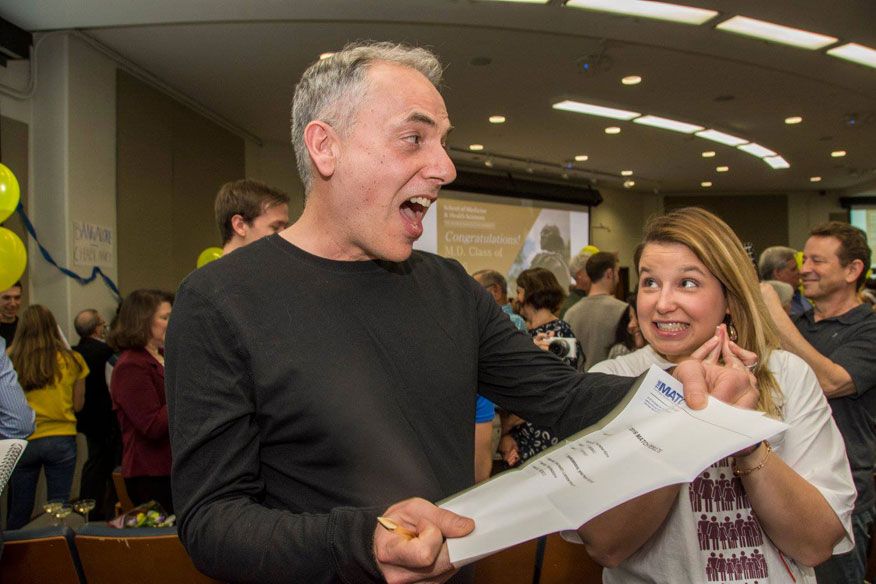
Paul Kline, a fourth-year medical student at the GW School of Medicine and Health Sciences (SMHS), stood with his wife, Mercedes, and their daughter, Coral, in Ross 101 on GW’s Foggy Bottom campus. They waited patiently while Kline’s fellow students and their friends and family members chatted and laughed, producing a nervous buzz that rose to a low roar in the crowded space.
“I’m excited for myself, and I’m excited for my friends,” Kline said, surveying the room.
What they waited for – finding out where they matched for their residency – was four years in the making.
“This is what they’ve worked so hard for over the last four years, and they completed a very competitive application process, interviewed at a number of hospitals,” explained Richard Simons, M.D., senior associate dean for M.D. programs and professor of medicine at SMHS. He added that several weeks ago, the students submitted their top choices for where they would like to train; hospitals with residency programs likewise submitted rankings of which students would be the best fit for their facilities. The National Resident Matching Program then used an algorithm to match each graduating medical student with a residency program.
Kline, for example, was hoping to match at Excela Health Latrobe Hospital in southwestern Pennsylvania. It was where he completed an associated internship, he said, and it felt like a perfect fit. “I know I’ll get a good education [there], and I think it’s just a great environment to be in.”
Matt Goldshore, Ph.D.(c), M.P.H. ’09, adjunct instructor of clinical research and leadership at SMHS, was hoping to match in general surgery either at the University of Pennsylvania or at the University of Southern California. It was, in some ways, a departure, he explained, from an earlier area of interest: maternal health. Between his second and third years of medical school at SMHS, Goldshore took time out to earn his Ph.D. at the Johns Hopkins University.
“I did a doctoral degree in population, family, and reproductive health, with a focus on social epidemiology, so studying how social constructs like race and socioeconomic status impact health outcomes,” he said. He returned to GW, where he taught in the Health Sciences program and where he had earlier earned a Master of Public Health degree. For the next step in his career, Goldshore felt it was time for a change.
“GW has been really good to me, and I think, after a decade, it’s probably good to see something else,” he said.
Sasha Shackelford was also preparing for a change; she was hoping to match at Yale University or one of a couple programs in New York, where her boyfriend will be relocating. “I’m trying to move north,” she said. “It’ll be really great to be near him, hopefully.”
As the Class of 2016 waited for the clock to strike noon, when every fourth-year medical student across the country would open their envelopes to find their match, Scott Schroth, M.D., M.P.H. ’90, associate dean for administration and associate professor of medicine at SMHS, reminded the students of the legacy that they would soon join.
“Many of you are going to programs where GW graduates have preceded you,” he said. “Sometimes you’re going there because they were so good, [the programs] wanted more. So that’s your job; you need to go out there and pave the way for the next generation of GW docs. That’s all you have to do. No pressure.”
With that, he instructed the students to collect their envelopes. In addition to information about their match, the fourth-year medical students also received letters from family and friends, solicited by first-year M.D. program students. Schroth added that third-year medical students provided the set-up for the event and glasses of champagne, and SMHS alumni hosted a barbecue and post-match celebration.
After a countdown from 10, the Class of 2016 opened their envelopes.
“I feel great, I feel awesome,” Kline said, beaming. “You work for four years, and you want to do a certain thing, and I just found out that that’s what I’m going to do.”
Kline matched at Excela Health. After an earlier career in electrical engineering, Kline said he is now following a career path that has both “head and heart.”
“A lot of times in medicine, there’s a fight between the heart and the brain,” he said. “You find you have a patient with a rare illness, [and] your brain is like, ‘oh my gosh, that’s cool!’ Then you’re thinking about the patient, [like] ‘oh my gosh, this person has whatever-it-is.’ I like it because it’s a good balance between the two.”
Kline and his wife, who has been a nurse for 25 years, plan to open a clinic in a “very rural area where there are no doctors. [We want to] make it sliding scale, or if people can’t pay, that’s fine. We just want to help.”
Goldshore and Shackelford also matched with their top choices, the University of Pennsylvania and Yale, respectively. The Class of 2016 also matched at institutions such as UCLA Medical Center, Johns Hopkins Hospital, Emory University, University of Virginia, and University of Maryland Medical Center. Eight students will continue their training at GW, and seven will train at Children’s National Health System in Washington, D.C.
A complete list of this year’s Match Day results is available.


